Nasir-ol Molk Mosque: The Pink Mosque of Shiraz
Renowned as the Pink Mosque or Rainbow Mosque, Nasir-ol Molk Mosque is one of the most ancient and stunning mosques in Shiraz, Iran, and offers a visual feast unlike any other.
It transforms into a breathtaking kaleidoscope as the morning sun rises. Sunlight filters through its intricate stained glass windows, casting a mesmerizing array of colors onto the walls and carpets. This magical display turns the mosque into a photographer’s paradise.
Built in the late 19th century, the Nasir-ol Molk mosque's exquisite deep blue tiling, delicate muqarnas, and vibrant polychrome faience showcase the pinnacle of Islamic architecture. Join us to learn more about this historic mosque.
Interested in visiting Nasir-ol Molk Mosque?
Check out our Shiraz tour packages to find an itinerary that includes visiting the mosque
or...
Design your own tailor-made itinerary and include Nasir-ol Molk Mosque in it by yourself, today!
Nasir-ol Molk Mosque History

The history of Nasir al-Mulk Mosque dates back to the Qajar era. Construction of this mosque began in 1914 in the Goud-e-Arabha neighborhood and was completed in 1926.
The mosque was built by the order of Mirza Hasan Ali, titled Nasir al-Mulk, one of the notable figures of the Qajar dynasty. He was the son of Ghavam-Ol Molk and his title was bestowed by the royal court because was known to be a just and fair ruler.
He named the mosque after himself to ensure his name would live on through this charitable work. The Nasir al-Mulk Mosque was built by Mohammad Hasan-e-Memar.
The mosque covers an area of approximately 2,212 square meters. The stained glass windows of Nasir al-Mulk Mosque in Shiraz were crafted by Mohammad Jafar and Master Mohammad Rahim, and were restored in 1969 by Mirza Ayat, a prominent stained glass craftsman from Shiraz.
In 1979, the Nasir al-Mulk Mosque was registered as a national monument of Iran by the Iranian National Heritage and Archaeology Association.
| Suggestion: Tomb of Hafez in Shiraz - Famous Persian Poet
Why is Nasir-ol Molk Mosque Important?
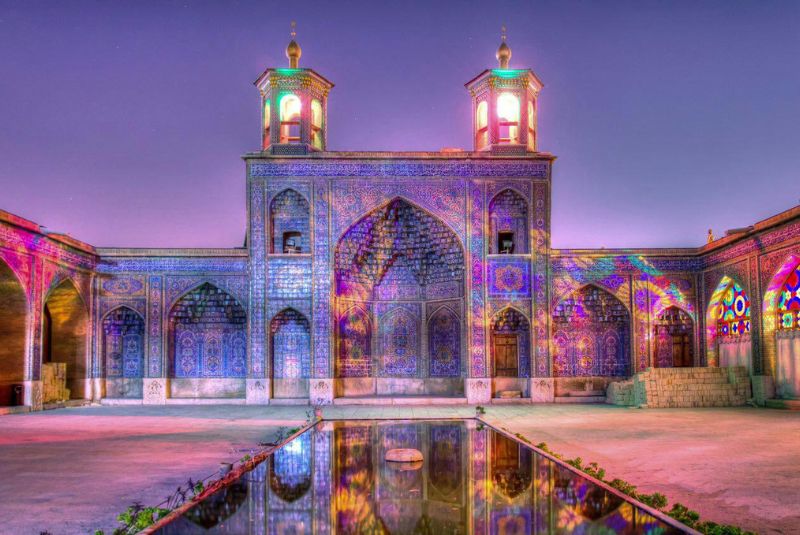
The Nasir ol Molk Mosque, also known as the Pink Mosque, holds significant cultural and architectural importance. Its stunning architecture, characterized by intricate tilework and colorful stained glass windows, reflects the mastery of Persian craftsmanship.
Beyond its aesthetic appeal, the mosque serves as a testament to the rich cultural heritage of Shiraz, Iran. As one of the few mosques with such elaborate interior design, it attracts tourists and pilgrims alike, offering them a glimpse into the artistic splendor of Islamic architecture.
Moreover, its historical significance as a place of worship adds to its importance in the hearts of believers and visitors.
| Related: Top 16 Most Beautiful Mosques in Iran
Nasir-ol Molk Mosque Architecture
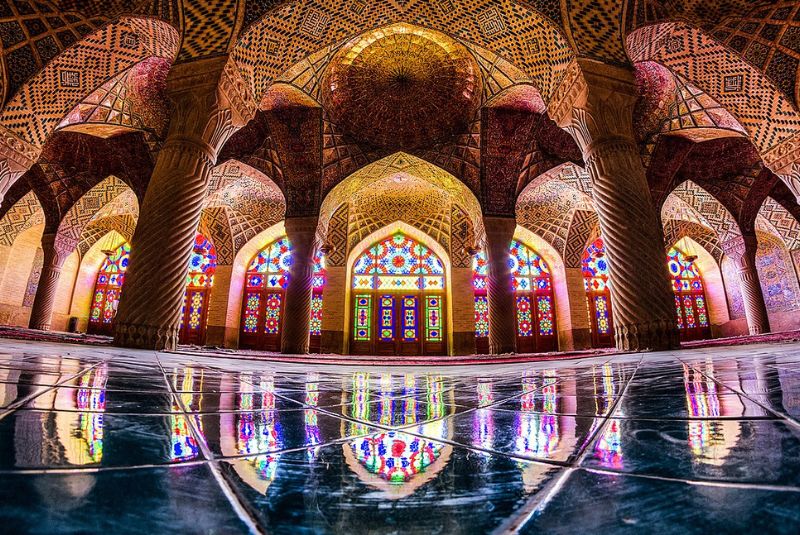
Nasir al-Mulk Mosque, covering 2,216 square meters and built on a 2,890-square-meter foundation, stands out as an architectural gem in Shiraz. Known for its exquisite tiling and muqarnas, it is considered one of the most precious mosques in Iran. Unlike typical Iranian mosques, Nasir al-Mulk lacks a dome, indicating its function as a personal structure rather than a public gathering place.
The mosque’s tiling is unparalleled, featuring intricate designs and a unique use of pink as the dominant color, setting it apart from other mosques in Iran. This mosque is referred to as the "Pink Mosque" due to the extensive use of tiles featuring pink roses, making pink the dominant color in its decoration.
The use of colorful stained glass throughout the mosque is another distinctive feature. These vibrant windows transform sunlight into a mesmerizing array of colors, creating a magical ambiance within the prayer hall.
This mosque features two iwans, one each on the northern and southern sides. However, the western prayer hall is the highlight, drawing numerous visitors to experience its captivating light and color display.
The mosque's design emphasizes symmetry, a hallmark of Iranian architecture. This is evident from the entrance, which features two decorative arches flanking the vestibule. The ceilings of each floor are adorned with European-style paintings, adding to the mosque's unique blend of artistic influences.
| Discover: Top 14 Religious Tourist Attractions in Iran
When was Nasir-ol Molk Mosque Built?
The mosque was constructed in 1914 the construction was finished after 12 years in 1926.
Prominent Architectural Features of Nasir al-Mulk Mosque
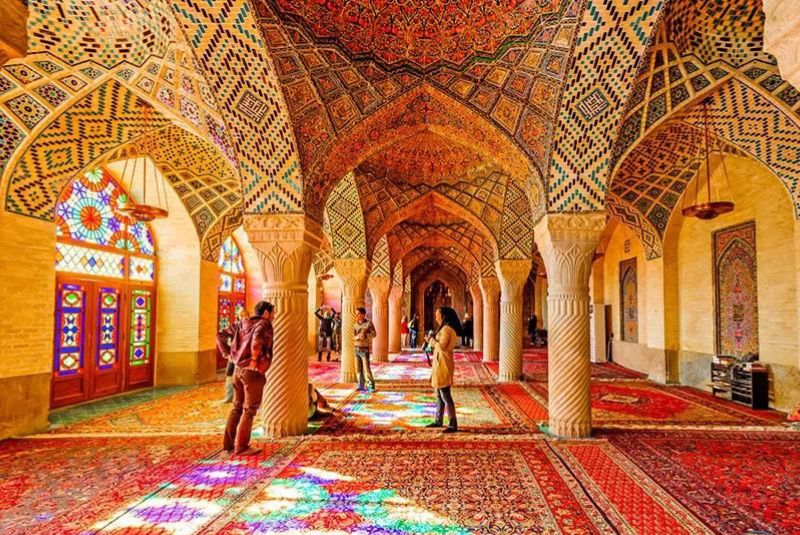
One of the most striking features of Nasir al-Mulk Mosque is its meticulously crafted architectural decorations. Below are some notable architectural features of Nasir al Mulk mosque:
Tiling
As you step into Nasir al-Mulk Mosque in Shiraz, you're greeted by a mesmerizing display of seven-color tiles adorning the entrance to the western prayer hall. Shades of pink, yellow, orange, white, turquoise, and blue create a vibrant tapestry, depicting colorful floral motifs, notably the pink-colored Mohammadan rose. This extensive use of pink tiles earned the mosque its nickname, the "Pink Mosque," showcasing the prominence of this hue throughout its walls.
Columns of Nasir-ol Molk Mosque
Notably, the mosque's columns are made of marble sourced from Shiraz, with spiral designs reminiscent of those found in the Vakil Mosque. These meticulously crafted columns can be observed beneath the vaults of the renowned western and eastern prayer halls. Functionality merges seamlessly with aesthetic appeal in these columns, contributing to the mosque's overall architectural beauty.
Nasir-ol Molk Mosque Stained Glass
The mosque's doors feature another exquisite decoration: stained glass panels adorning every entrance to the prayer halls. Crafted from intricately carved wood, these doors are adorned with colorful stained glass panels in shades of yellow, blue, green, and red.
When sunlight filters through these panels, it casts a spectrum of colorful hues into the mosque, creating a mesmerizing interplay of light and color. This radiant display, particularly in the western prayer hall during the morning hours, highlights the enduring beauty of stained glass in Iranian architecture, enhancing the interior ambiance of Nasir al-Mulk Mosque.
| Related: Elements of Persian Architecture
Different Parts of Nasir al-Mulk Mosque
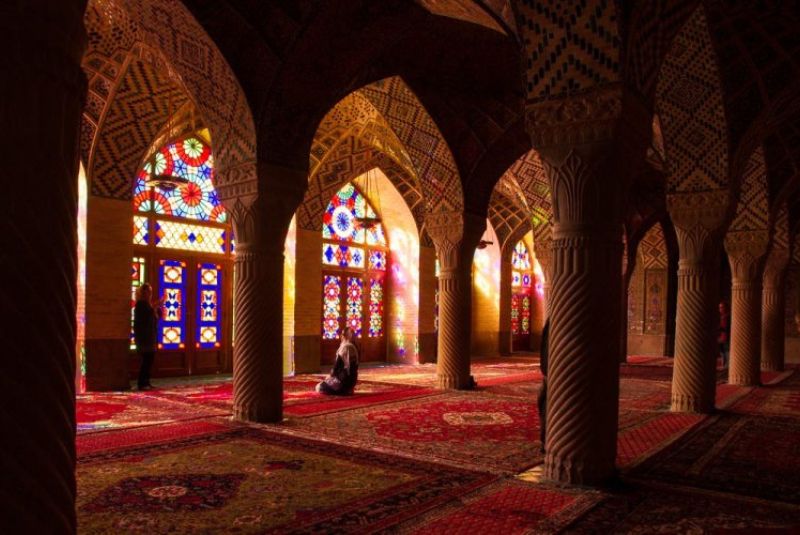
As you step inside from the brick entrance, you enter a courtyard that is spacious and enchanting. The central fountain, surrounded by planters, adds to the charm. While the buildings surrounding the courtyard might seem similar to other mosques, this is just the beginning of the story.
In the north, you'll find the Pearl Pavilion, while in the south, the South Pavilion and floral motifs await. The pavilions, although not perfectly symmetrical, are a sight to behold. The east features a well and a vestibule with seven colorful columns, while in the northeast corner, you'll find another courtyard housing the Imamzadeh Zanjiri.
Main Courtyard
What truly distinguishes Nasir-ol Molk Mosque among tourists are the scenes witnessed within its main courtyard. From the ceiling to the windows and the columns of the western pavilion, everything is visually striking. The tilework is captivating, and if you raise your head high, the ceiling's decorations and architecture will mesmerize you.
Western Pavilion
The western pavilion boasts twelve sets of six columns, reminiscent of the twelve Imams. The spirals on the columns always catch the tourists' attention.
Among these beautiful columns are seven fountain niches that collectively create a charming view. Alongside them lies the mihrab, slightly lower than the level of the courtyard, adorned with marble stones.
Well
Despite the modern amenities we have today, it's hard to imagine life two hundred years ago. Sometimes, they used animals like cows to draw water from the well. The well of Nasir-ol Molk Mosque is ancient and used to provide water for animals. The water would then flow into a basin and spout from the courtyard fountain.
Imamzadeh Zanjiri
Imamzadeh Sayyid Jalaluddin, a descendant of Imam Sajjad, is renowned as Imamzadeh Zanjiri. His tomb is situated in the northeastern corner of Nasir-ol Molk Mosque, within a small courtyard. The structure of Imamzadeh Zanjiri dates back to the Safavid era, although some decorations were added during the Zand and Qajar periods.
Entrance Portal
The entrance portal of Nasir al-Mulk Mosque comprises a vestibule adorned with intricate muqarnas work. Two identical muqarnas motifs adorn the east and west sides.
The entire entrance is covered with seven-color tiles, depicting a vibrant mosaic. Noteworthy is the use of stone carving on the top of the entrance, featuring verses by the renowned Shirazi poet, Shurideh Shirazi, commemorating the completion of the mosque. When visiting this area, take a moment to admire the intricately crafted muqarnas ceiling.
Octagonal Vestibule
The octagonal vestibule, though less decorated than the entrance portal, boasts elaborate mosaic tiles. Octagonal structures like this were commonly used in Iranian architecture for their inward focus. Typically, an octagonal vestibule features an eight-sided design with a small dome at the top. Inside the small dome of Nasir al-Mulk Mosque's vestibule, you'll find exquisite tilework. After passing through the vestibule, visitors enter the courtyard.
Northern Iwan (Marble Iwan)
The northern iwan, also known as the Marble Iwan, lacks floral motifs but features a decorative gold collar. It consists of three semi-iwans and serves as an entrance to the courtyard from the fourth side.The ceiling is adorned with muqarnas and mosaic tiles, providing a visual spectacle. The walls of the northern iwan boast exquisite tilework, contributing to its architectural splendor.
Southern Iwan (Pearl Iwan) with Floral Motifs
The southern iwan features floral motifs and is accompanied by floral decorations. Typically, floral motifs and domes indicate the architectural significance of a space. The mosque's southern section is structured as iwans, with a large dome missing. The use of colorful mosaic tiles and marquetry decorates all the walls in the southern section. Don't forget to capture the reflection of the southern iwan in the water basin for stunning architectural photography.
Eastern Prayer Hall
The eastern prayer hall is a simpler section of the mosque, featuring marble columns and brick iwans devoid of mosaic tiles. In the past, this area was used during the summer months.
Access to the water well is through a corridor known as the "water well corridor." Today, this area serves as the Endowments Museum, with no prayers held here. The eastern prayer hall represents the simplest interior space of Nasir al-Mulk Mosque in Shiraz.
| Discover: The Most Beautiful Gardens in Shiraz
Nasir-ol Molk Mosque Location
Nasir al-Mulk Mosque is situated in the neighborhood of Goudarban, on Lotf Ali Khan Zand Street in Shiraz.
| Also read about: Shah Cheragh Mausoleum
How to Get to the Mosque
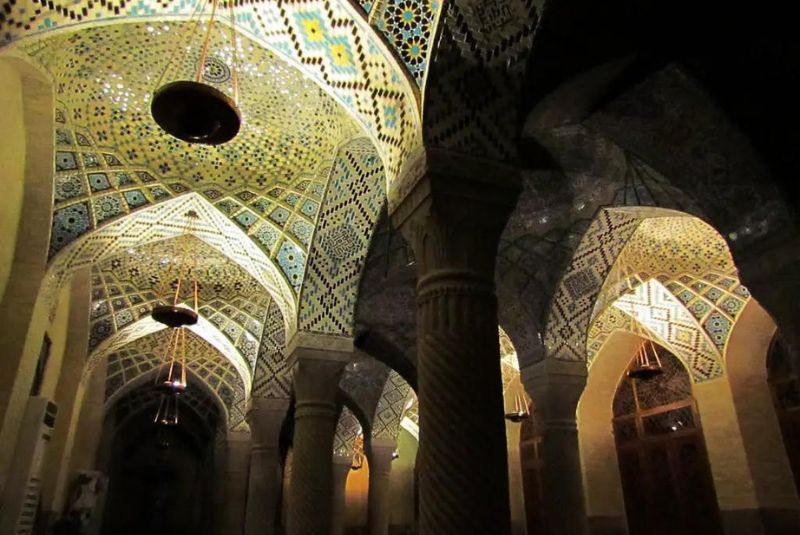
Accessing this location is possible through the following methods:
Metro
The nearest Shiraz metro station to the mosque is Valiasr Station on Line 1. Upon reaching Valiasr Station, you have two options: You can hail a taxi from Valiasr Station and request to be taken to Nasir-ol Molk Mosque. It's approximately a 1.5-kilometer distance.
If you prefer walking, you can cover the 1.5-kilometer distance on foot. Follow the directions to Nasir-ol Molk Mosque from Valiasr Station.
Bus
If you plan to use the bus, you can board buses running on the Valiasr-Namazi route. Once you reach Chahar Rah Moshir Station, disembark from the bus. After getting off the bus, locate Nasir-ol Molk Mosque in the vicinity. It should be within walking distance from the bus stop.
| Related: Best Restaurants in Shiraz You Shouldn't Miss!
Nasir-ol Molk Mosque Nearby Tourist Attractions
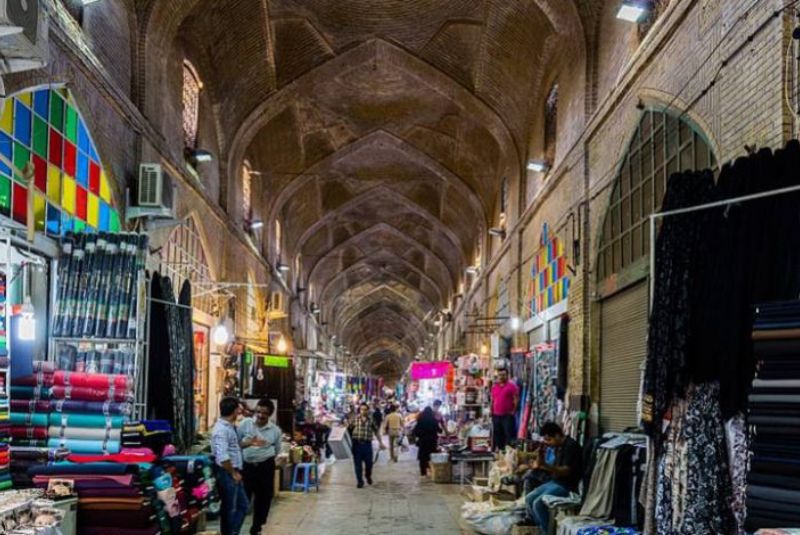
Nasir ol Molk Mosque is not far from the famous tourist attractions of Shiraz. If you enjoy walking, you can reach Vakil Bazaar with just a fifteen-minute walk, located about 1,300 meters away from the mosque.
The Vakil Complex can keep you engaged for several hours with its rich history and vibrant atmosphere. Afterward, you can pay a visit to Shah Cheragh Shrine, conveniently located in the vicinity, for spiritual contemplation and exploration.
| Discover: Best Hotels in Shiraz You Never Want to Leave
Best Time to Visit Nasir-ol Molk Mosque
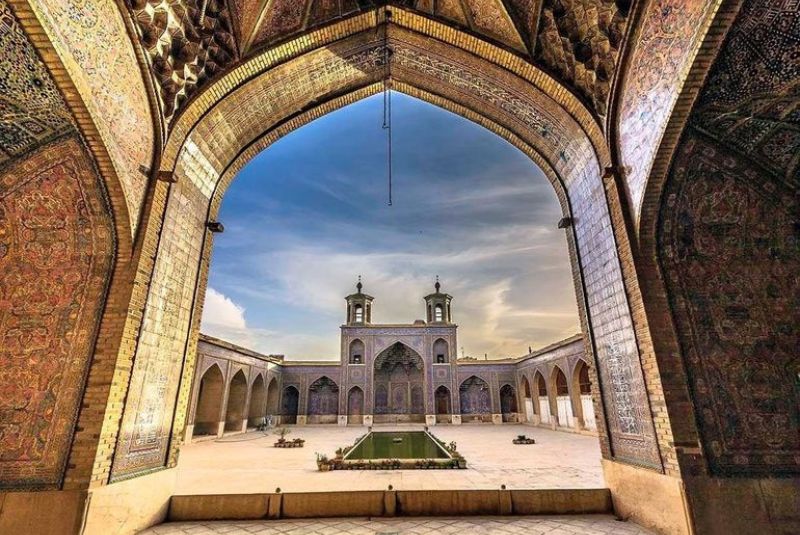
The best time to visit Nasir-ol Molk Mosque is when you travel to Shiraz. While the ideal time to travel to Shiraz is during the spring season, you can visit the pink mosque in Shiraz anytime you visit this city. However, to truly appreciate the architecture and beauty of this mosque, you should choose the right time of the day.
The optimal time for visiting Nasir-ol Molk Mosque is from 8:00 AM to 10:00 AM. During this time, the sunlight enhances the architectural details and colors of the mosque, creating a mesmerizing spectacle. You can capture stunning photographs during this time window.
| Read more: Top 15 Traditional Hotels in Shiraz
Opening Hours
You can visit here from 7:30 AM to 7:00 PM during spring and summer. However, during autumn and winter, the visiting hours for Nasir ol Molk Mosque change to 7:00 AM to 5:50 PM. Remember, visiting is not possible on official holidays.
| Discover: Shiraz Maharloo Lake - Red Waters, Green Initiatives
Ticket Price
The ticket price is 5,000 Tomans for domestic tourists and 20,000 Tomans for foreign tourists.
| Also might be interesting: Shiraz Eram Garden - Paradise on Earth
Bottom Line
Nasir-ol Molk Mosque stands as a testament to the exquisite Persian architecture. Its kaleidoscopic stained glass windows, intricate tilework, and serene ambience offer visitors a mesmerizing experience.
Beyond its architectural marvels, the mosque embodies a profound connection to Shiraz's heritage, drawing pilgrims and tourists alike to bask in its beauty and tranquility. If you are planning to travel to Shiraz, be sure to visit this beautiful mosque.
Share your story!
Comment below and let us know about your Experience.
Your story inspires others!


Comment
Leave a Comment